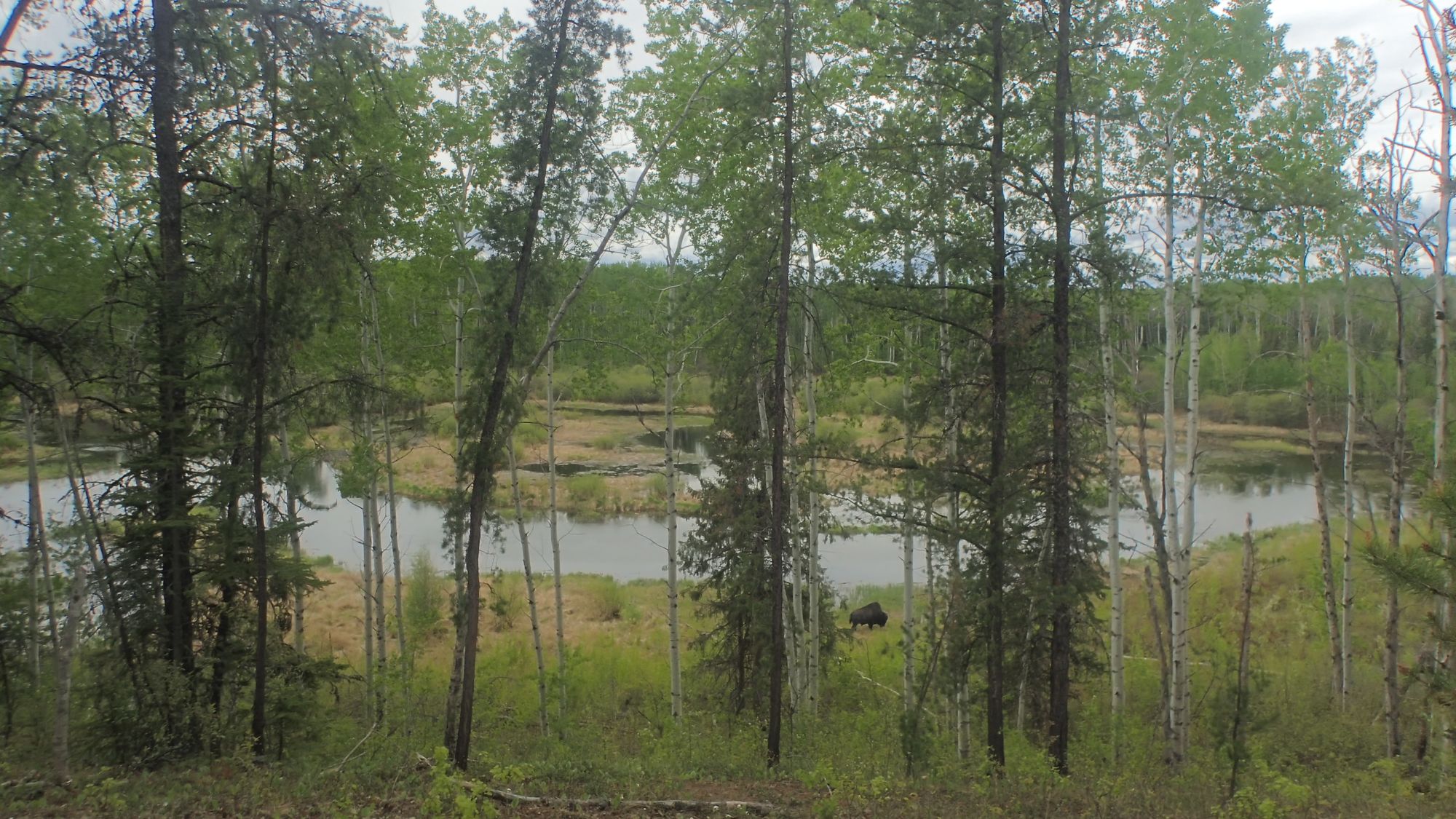Ronald Lake wood bison ecology

For my PhD dissertation, I have had the priviledge to conribute to the ecological knowledge of one of the most interesting populations of animals in the world. The Ronald Lake wood bison (Bison bison athabascae) herd has a fascinating history and ecology that makes then unique. Many are familiar with the story of bison in North America; once numbering near 30 million, bison were nearly extirpated from North America due to over hunting driven by market demand by 1900 (Cunfer and Waiser 2016). Around this time efforts were made by a number of individuals across the continent to preserve the remaing bison herds. In Texas, Charles Goodnight allowed the last bison of the southern plains to coexist with his cattle on his ranch in the 1870s. In New York, William T. Hornaday acquired bison for presevation at the Bronx Zoo and founded the American Bison Society in 1905. In Montana, Samuel Walking Coyote brought a handful of bison calves back from one of the last bison hunts in 1873. He would eventually sell these animals to C.A. Allard and Michel Pablo who bred these individuals into a herd of hunderds. The Pable-Allard herd would then be sold to the Canadian Government to help establish a conservation herd at Elk Island National Park near Edmonton, Alberta. These Elk Island bison would be used to establish and bolster conservation herds for the next century and beyond.
In the mid-1920s bison from Elk Island would be loaded up in freight cars and shipped north to bolster the bison populations in Wood Buffalo National Park which straddles the border of Alberta and the Northwest Territories (Nishi 2017). However, there were two issues with this conservation strategy unbenounced to park employees at the time. First, Elk Island is closely surrounded by farms and ranches and as a result the bison were exposed to domesticated livestock (i.e., cattle and sheep). The bison shipped to Wood Buffalo had bovine tuberculosis and brucellosis both of which result in still-births and therefore are detrimental to population fitness. Second, there was no effort to maintain genetic integrity between the two American bison (Bison bison) subpecies: 1) plains bison (B. b. bison, which are what most people think of as bison and occupy the plains of the USA and Canada. 2) wood bison (B.b. athabascae, the largest terrestial animals in North America, darker, have a larger hump and shaggier main, and inhabit boreal forests). As a result, the Wood Buffalo National Park bison herds are infected by bovine tubercolusis and/or brucellosis and have a genetic structure that is a mix of wood and plains bison.
Ronald Lake is roughly 10-km south of the southern boundary of Wood Buffalo National Park. A population of bison was known to exist in the area surrounding Ronald Lake but the Canadian government insisted that population was simply a split from the Wood Buffalo National Park bison. However, members of First Nations and Métis community members had stories passed down from their grandparents that contradicted the idea that the Ronald Lake bison were a recent break-off of the recently introduced Wood Buffalo bison. The controversy came to a head in 2012 when Teck Resources Limited leased the land rights to the Ronald Lake herd's range and proposed to construct an open-pit oil sands mine. Athabasca-Chipewyan First Nation's elder, P.M. (I use initials to maintain individual privacy), used the power of his nation's treaty rights to insist that the Ronald Lake herd be recognized by the provincial and federal government, and receive conservation status. Their petitions resulted in the Government of Alberta conduction genetic and disease testing on individuals in the Ronald Lake herd. The results gave support to the assertions of the communites; the Ronald Lake herd is disease free and genetically distinct from other local populations (Shury et al. 2015, Ball et al. 2016). The Ronald Lake wood bison are now designated as Subject Animals under Alberta's Wildlife Act, and wood bison are listed as Threated under Schedule 1 of Canada's Species at Risk Act (SARA) and Special Concern by the Committee on the Status of Endangered Wildlife in Canada. In addition, the Ronald Lake Wood Bison Technical Team and Ronald Lake Bison Herd Comanagement board have been established to identify the knowledge necessary for the sound management of the herd and its habitat.
In Sepetmber of 2017, I signed on to conduct a PhD dissertation investigating how the nutritional ecology of the Ronald Lake bison influences thier habitat selection. I am co-supervised by researchers at the University of Alberta, Dr. Scott Nielsen, and the Royal Alberta Museum, Dr. Mark Edwards. We work cloesly with the Ronald Lake wood bison herd technical team and my resaearch questions were designed to address knowledge gaps identified by the techical team. Please refer to research specifics in the posts on this website. My dissertation has led me to build a field camp, spender hundered of days in the field, and publish the results of my data collection. Please view the posts related to my publications for further details. Research on the Ronald Lake wood bison herd will extend beyond my research an deserves the attention of anyone interested in North American fauna.
Literature cited:
Alberta Environment and Parks and Alberta Conservation Association. 2017. Status of the American Bison (Bison bison) in Alberta: Update 2017. Alberta Environment and Parks. Alberta Wildlife Status Report No. 38 (Update 2017). Edmonton, AB. 134 pp.
Ball MC, Fulton TL, Wilson GA (2016) Genetic analyses of wild bison in Alberta, Canada: implications for recovery and disease management. Journal of Mammalogy. 97: 1525–1534.
Cunfer G, Waiser WA (2016) Bison and People on the North American Great Plains: a Deep Environmental History. Texas A&M University Press, College Station, Texas, USA.
Shury, T.K., Nishi, J.S., Elkin, B.T., and Wobeser, G.A. 2015. Tuberculosis and brucellosis in wood bison (Bison bison athabascae) in northern Canada: A renewed need to develop options for future management. Journal of Wildlife Disease 51(3): 543–554